Clare farmer Diarmaid Fitzgerald was this week announced as the winner of the 2022 Grassland Farmer of the Year. The young farmer from Cratloe impressed the judges with his knowledge and use of clover, excellent grassland management skills and for farming in a sustainable manner.
Diarmaid is milking 150 cows on the 67ha farm which has varying soil type with about 60% of the farm free-draining limestone land and the remaining 40% low-lying land protected from the Shannon Estuary by levees. Luckily for Diarmaid, he was able to graze all of this land in February and didn’t need to graze it in the wet during March and April.
When the Irish Farmers Journal visited the Fitzgerald farm earlier this week, the cows were grazing a nice cover of 1,500kg of grass and clover. The average farm cover is 172 per cow, growth rate is 72kg/day and the cows, which are a mix of Jersey crossbred and Holstein Friesian were milking 1.84kg MS/cow from 1.5kg of meal. The cows have been on 1.5kg of meal for the last three weeks and got no more than 3kg of meal all spring.
Diarmaid is walking the farm every five days and putting the figures into PastureBase. His aim is to keep the cover at around 170kg/cow. Ten days ago it went to 240kg/cow so he skipped over four paddocks and made 70 bales from them. This will be the regime from now until the middle of August, with Diarmaid normally making around 250 round bales from surplus paddocks that will be fed back to the milking cows if needs be next spring.

The field the cows are going into next will be closed for second cut silage after grazing.
First-cut pit silage was also completed last week – he cut and weighed these fields at over 4t DM/ha. They were mostly the low-lying fields grazed in February. They got the equivalent of 70 units of nitrogen per acre between slurry and protected urea and will get the same now for second cut, with a full slurry tower ready to be applied to these fields.
I asked Diarmaid if he was not tempted to let the silage bulk up a bit more before cutting it: “I was happy with the yield and there was a quarter of a pit of silage left over at the end of the winter just gone so I’m not stuck for silage.
“The first and second cut from last year both tested over 70% DMD so the quality is good. I cut 37 acres for first cut but have 55 acres closed for second cut. I’ve had smaller first cuts the last few years because I take a good bit of ground out for reseeding. I find that if you reseed early the fields will still grow 12t to 14t in the year,” he says.
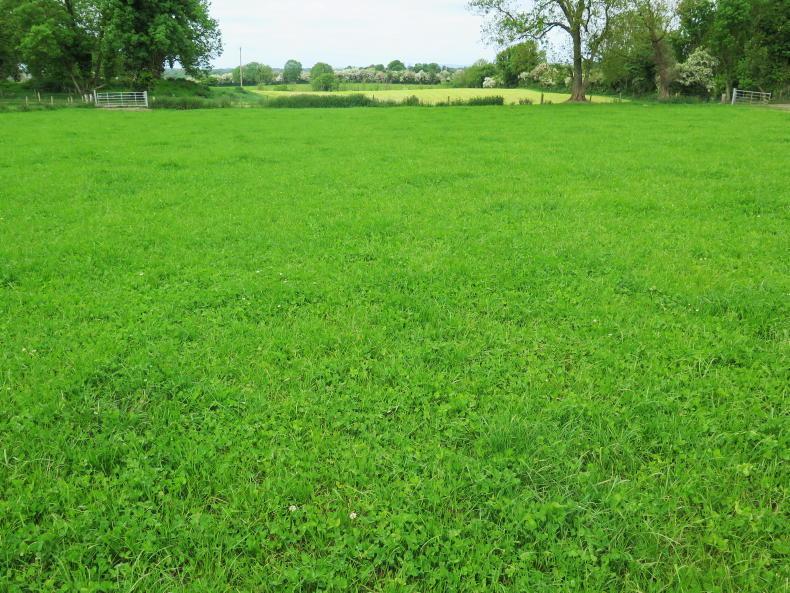
This field of red and white clover and perennial ryegrass was reseeded last year and has a huge clover content now having not received any chemical nitrogen in over 12 months
Diarmaid currently has 14% of the farm out for reseeding. This was sown on 19 April with a slot seeder. The field was burned off, well grazed, got 1t/acre of lime and two bags/acre of 10:10:20 and was then sown in a criss-cross way before being rolled. Timing was perfect and with a lot of rain after falling since, the reseeds are looking really well.
This year’s seed mixture and last year’s seed mixture both contain red and white clover at a rate of 2kg per acre of naked clover seed each. Apart from getting chemical nitrogen at sowing, Diarmaid gives these fields no more chemical nitrogen but they do get extra P and K;
“I suppose our thinking around managing clover is constantly evolving. This is what I’m doing now but that’s not to say it won’t change in the future. Red clover was only used for the first time last year so it’s too early to say how long it will last but even if it does die out there should still be plenty of white clover to keep the sward going.”

This field was reseeded with red and white clover and grass on 19 April. The thistles in the background emerged after the field was sprayed off.
One of the fields reseeded last year is a mass of both red and white clover and this field got no chemical nitrogen in over 12 months. It was getting a half bag/acre of 0:7:30 once a month last year and the plan is to use 0:7:30 and sulphate of potash to get phosphorus, potash and sulphur applied this year. There is 27% of the farm getting no chemical nitrogen, including this year’s reseeds.
Diarmaid is following the Teagasc guidelines for the fields with good white clover contents. They got normal rate nitrogen up to now, about 90 units/acre on average and will get seven units/acre of nitrogen after grazing for the rest of the year, with the option to spread more in the last round. Interestingly, all of the grazing ground contains high levels of clover, with any low clover fields closed up for second-cut silage.
Diarmaid started breeding on 1 May and the first of the repeats started earlier this week. All the maiden heifers are reared by a contract rearer and these were inseminated after a full CIDR programme with sexed semen. A vasectomised bull will run with the heifers now for the next few weeks and scratch cards will be put on to help pick up repeats before an Angus bull will run with them for the rest of the season.
Sexed semen
Only sexed semen is being used to generate replacement heifers. Even the heifers that repeat will be served with Aberdeen Angus AI. Diarmaid also used fixed time AI on this 30 best cows.
They were picked based on lactation, days from calving and body condition score and all 30 were served with sexed Holstein Friesian semen on the first day of AI. All other cows have been served with a team of four Belgian Blue AI bulls.

This field was reseeded with red and white clover last year.
“I used all sexed semen last year too but this is my first year using the CIDRs on the cows so it’ll be interesting to see how it goes. All of my dairy heifer calves should be born in the first week of February next spring.
“I used a mix of Charolais and Belgian Blue AI bulls last year but felt that the Belgian Blue were a bit easier calving so have stuck with them this year. I’ll do 11 weeks of AI and don’t use any stock bulls on cows,” he says.
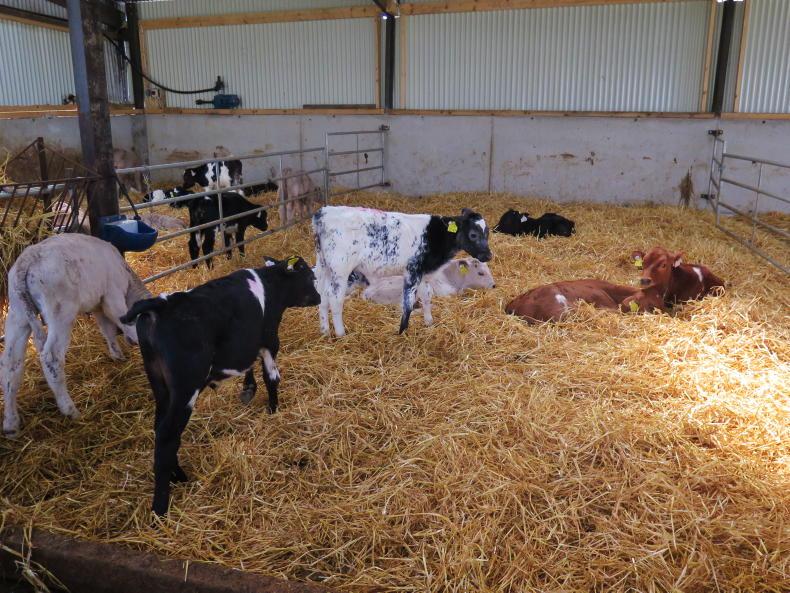
Some of the Belgian Blue and Charlaois calves on the Fitzgerald farm.
Demand for calves is good, with Diarmaid selling the calves privately at four to five weeks of age for €200 to €350 a head.
A new calf shed and computerised calf feeder were installed last year which he says have been a huge labour saver.
Apart from part-time help in the spring Diarmaid is running the farm himself, taking every Saturday and Sunday evening off.
Contractors do all the silage, slurry and fertiliser work. There is no real machinery on the farm and the system is simple, with the heifers contract-reared and the focus being on cows, clover and grass. Diarmaid is a worthy winner of the competition.
Clare farmer Diarmaid Fitzgerald was this week announced as the winner of the 2022 Grassland Farmer of the Year. The young farmer from Cratloe impressed the judges with his knowledge and use of clover, excellent grassland management skills and for farming in a sustainable manner.
Diarmaid is milking 150 cows on the 67ha farm which has varying soil type with about 60% of the farm free-draining limestone land and the remaining 40% low-lying land protected from the Shannon Estuary by levees. Luckily for Diarmaid, he was able to graze all of this land in February and didn’t need to graze it in the wet during March and April.
When the Irish Farmers Journal visited the Fitzgerald farm earlier this week, the cows were grazing a nice cover of 1,500kg of grass and clover. The average farm cover is 172 per cow, growth rate is 72kg/day and the cows, which are a mix of Jersey crossbred and Holstein Friesian were milking 1.84kg MS/cow from 1.5kg of meal. The cows have been on 1.5kg of meal for the last three weeks and got no more than 3kg of meal all spring.
Diarmaid is walking the farm every five days and putting the figures into PastureBase. His aim is to keep the cover at around 170kg/cow. Ten days ago it went to 240kg/cow so he skipped over four paddocks and made 70 bales from them. This will be the regime from now until the middle of August, with Diarmaid normally making around 250 round bales from surplus paddocks that will be fed back to the milking cows if needs be next spring.

The field the cows are going into next will be closed for second cut silage after grazing.
First-cut pit silage was also completed last week – he cut and weighed these fields at over 4t DM/ha. They were mostly the low-lying fields grazed in February. They got the equivalent of 70 units of nitrogen per acre between slurry and protected urea and will get the same now for second cut, with a full slurry tower ready to be applied to these fields.
I asked Diarmaid if he was not tempted to let the silage bulk up a bit more before cutting it: “I was happy with the yield and there was a quarter of a pit of silage left over at the end of the winter just gone so I’m not stuck for silage.
“The first and second cut from last year both tested over 70% DMD so the quality is good. I cut 37 acres for first cut but have 55 acres closed for second cut. I’ve had smaller first cuts the last few years because I take a good bit of ground out for reseeding. I find that if you reseed early the fields will still grow 12t to 14t in the year,” he says.

This field of red and white clover and perennial ryegrass was reseeded last year and has a huge clover content now having not received any chemical nitrogen in over 12 months
Diarmaid currently has 14% of the farm out for reseeding. This was sown on 19 April with a slot seeder. The field was burned off, well grazed, got 1t/acre of lime and two bags/acre of 10:10:20 and was then sown in a criss-cross way before being rolled. Timing was perfect and with a lot of rain after falling since, the reseeds are looking really well.
This year’s seed mixture and last year’s seed mixture both contain red and white clover at a rate of 2kg per acre of naked clover seed each. Apart from getting chemical nitrogen at sowing, Diarmaid gives these fields no more chemical nitrogen but they do get extra P and K;
“I suppose our thinking around managing clover is constantly evolving. This is what I’m doing now but that’s not to say it won’t change in the future. Red clover was only used for the first time last year so it’s too early to say how long it will last but even if it does die out there should still be plenty of white clover to keep the sward going.”

This field was reseeded with red and white clover and grass on 19 April. The thistles in the background emerged after the field was sprayed off.
One of the fields reseeded last year is a mass of both red and white clover and this field got no chemical nitrogen in over 12 months. It was getting a half bag/acre of 0:7:30 once a month last year and the plan is to use 0:7:30 and sulphate of potash to get phosphorus, potash and sulphur applied this year. There is 27% of the farm getting no chemical nitrogen, including this year’s reseeds.
Diarmaid is following the Teagasc guidelines for the fields with good white clover contents. They got normal rate nitrogen up to now, about 90 units/acre on average and will get seven units/acre of nitrogen after grazing for the rest of the year, with the option to spread more in the last round. Interestingly, all of the grazing ground contains high levels of clover, with any low clover fields closed up for second-cut silage.
Diarmaid started breeding on 1 May and the first of the repeats started earlier this week. All the maiden heifers are reared by a contract rearer and these were inseminated after a full CIDR programme with sexed semen. A vasectomised bull will run with the heifers now for the next few weeks and scratch cards will be put on to help pick up repeats before an Angus bull will run with them for the rest of the season.
Sexed semen
Only sexed semen is being used to generate replacement heifers. Even the heifers that repeat will be served with Aberdeen Angus AI. Diarmaid also used fixed time AI on this 30 best cows.
They were picked based on lactation, days from calving and body condition score and all 30 were served with sexed Holstein Friesian semen on the first day of AI. All other cows have been served with a team of four Belgian Blue AI bulls.

This field was reseeded with red and white clover last year.
“I used all sexed semen last year too but this is my first year using the CIDRs on the cows so it’ll be interesting to see how it goes. All of my dairy heifer calves should be born in the first week of February next spring.
“I used a mix of Charolais and Belgian Blue AI bulls last year but felt that the Belgian Blue were a bit easier calving so have stuck with them this year. I’ll do 11 weeks of AI and don’t use any stock bulls on cows,” he says.

Some of the Belgian Blue and Charlaois calves on the Fitzgerald farm.
Demand for calves is good, with Diarmaid selling the calves privately at four to five weeks of age for €200 to €350 a head.
A new calf shed and computerised calf feeder were installed last year which he says have been a huge labour saver.
Apart from part-time help in the spring Diarmaid is running the farm himself, taking every Saturday and Sunday evening off.
Contractors do all the silage, slurry and fertiliser work. There is no real machinery on the farm and the system is simple, with the heifers contract-reared and the focus being on cows, clover and grass. Diarmaid is a worthy winner of the competition.








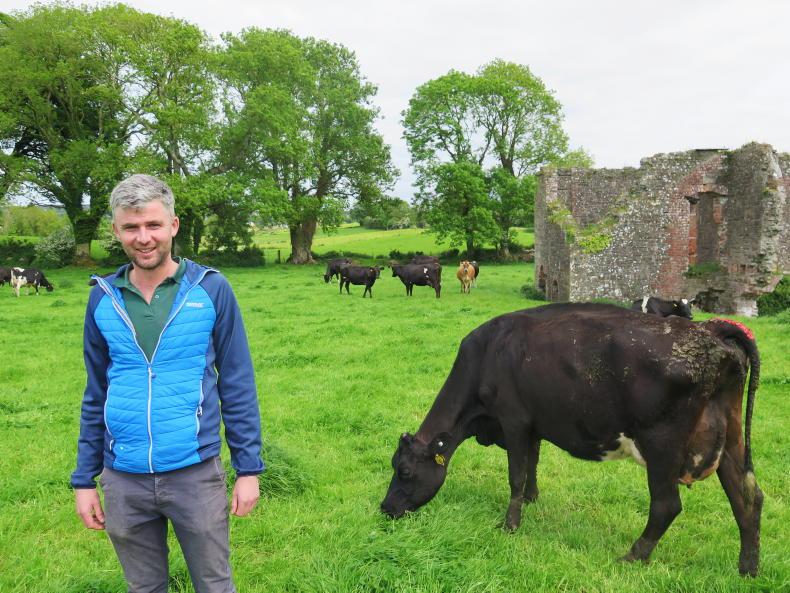

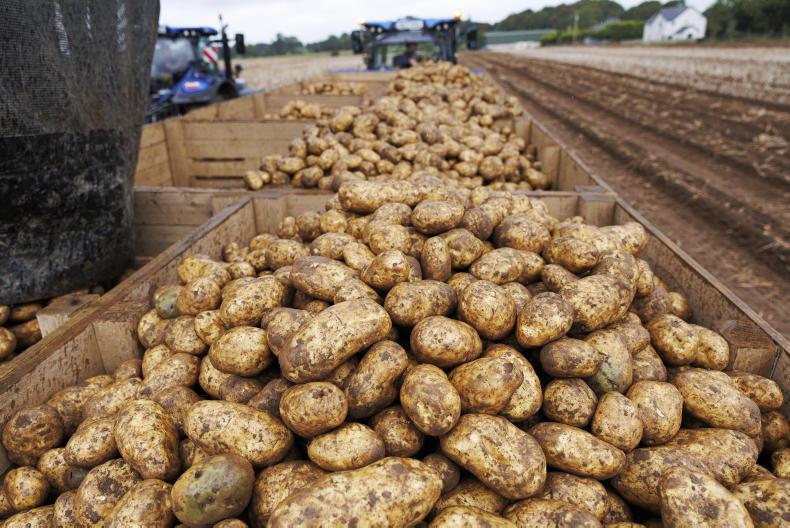
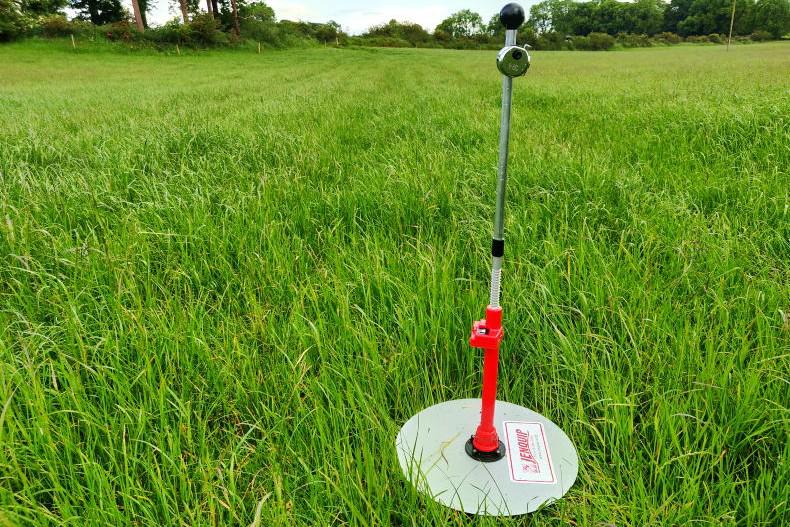
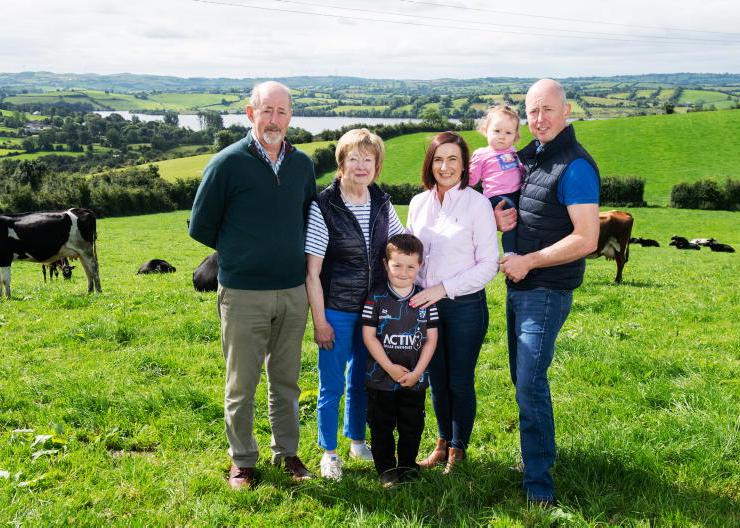
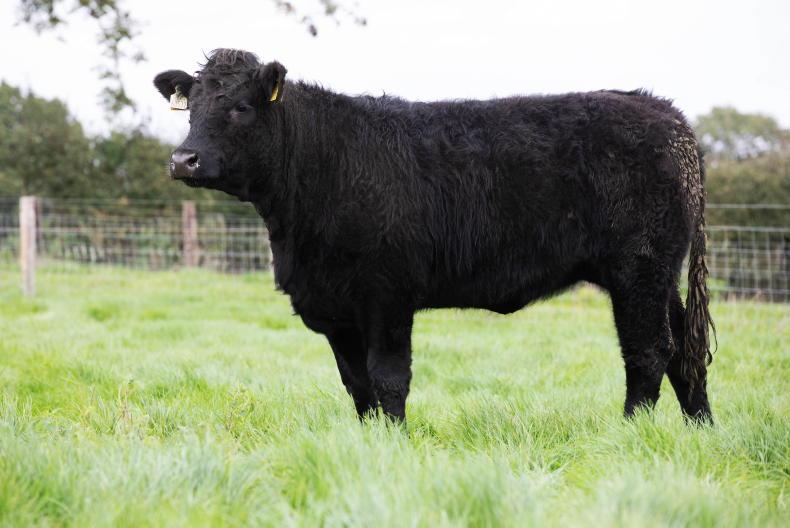
SHARING OPTIONS